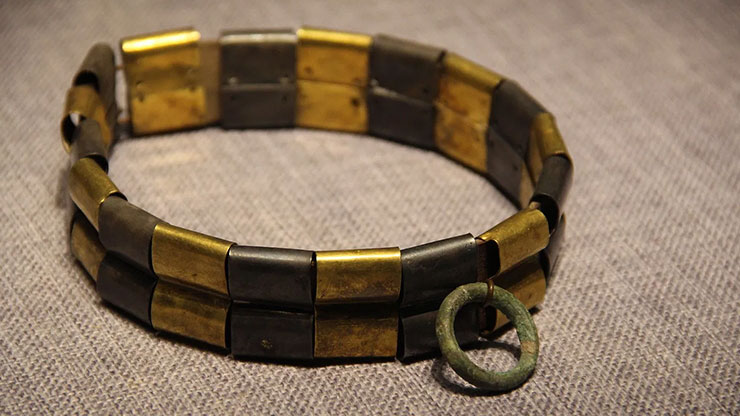
The Color of Safety
Color is all around us. Many times, different colors have different meanings. Did you know this can also apply to dog collars and leashes? Yes! Different colors used on leashes and collars can give you important information about a person’s dog long before you approach them. From “My dog is friendly” to “Stay away,” this article explains what colors are used for dogs and what each color means!

Harold Godwinson on a Hunt, Bayeux Tapestry - Thincat (Public Domain)
The History of Dog Collars
Throughout history, the collars that dogs wore reflected their status and the status of their owner. Dog collars have been used worldwide since ancient times and have since evolved in both design and purpose. Collars were believed to be first created in the ancient Mesopotamian regions. During those times, early collars consisted of simple cords around a dog’s neck. Eventually, as more materials became available, such as leather and cloth, the designs improved and became more elaborate. These collars were attached to a simple leash, or sometimes a stick, to better control the dog. In many historic artistic depictions, collars are absent on lower-class, working animals. However, pictures of dogs belonging to the upper class were typically depicted donning ornate collars.

Chinese Warring States Period Collar 481-221 BCE: Gary Todd (Public Domain)
Other examples of later collar designs included choke chains and spike collars, which were developed in Greece. These collars were used not only to control a dog but to protect its neck from animal attacks while hunting, for example. Other collars were used to irritate, agitate, and provoke dogs for sport in some cases. In other cultures, dogs often wore collars with bells on them. The Chinese and Japanese viewed dogs as protectors against ghosts and used the bells on collars to help ward off evil spirits.
Modern Collars and Leashes
Although collars and leashes have changed over time, the basic concept has remained the same: to keep the dog by the handler's side. Nowadays, collars and leashes are made in many different types of materials like leather, nylon, or polyester. Collars also usually carry some form of identification and record of vaccinations required by law in most states. As for leashes, any dog not within a fenced enclosure is encouraged to be on a leash or a lead. Even if one dog may be perfectly trained, another dog may not be so well-behaved or trained. Keeping all dogs on leashes can help prevent unnecessary accidents or negative interactions. This is part of what led to the push for specific collar and leash colors to convey information. Since collars are worn on dogs in public almost every day, it made sense that a collar could be the ideal tool to convey whether a dog was safe to approach.
It all started with the Yellow Dog Project, which used yellow ribbons and bandanas in training classes to convey a dog's level of comfort with being approached. Terry Ryan is a renowned dog trainer and behaviorist who recognized that sometimes dogs need space and a way for people to know this about them. Daily Paws states, “The yellow ribbon movement began in Australia in 2000 after Terry Ryan established the signal in her camps and classes. The yellow signal was used to communicate that a dog needed space. The campaign first spread to Australian dog clubs and then made its way to other countries.”

“The project gained traction, and Norway dog behaviorist, Mimmi Engh, borrowed it for their dog training classes for use with sensitive dogs. Eva Oliversson launched the first official program, International Gulahund™ Yellowdog, in Sweden in 2012 (http://gulahund.se/).” This movement is not as widely known in the United States. It could help dogs and owners be more aware when interacting with others and save people from having incidents with dogs that are not comfortable with being approached. Dogs could need space for several reasons, including if the dog is recovering, is in season, is old/tired, scared or insecure, is not well, is in training, or is deaf/blind.
One man that has helped this movement along was Jonathan Saville and his Staffordshire Bull Terrier, Roxy, in 2007. For many years of Saville’s time with Roxy, he got used to people avoiding them when they went places together. This avoidance stemmed from the stereotype surrounding breeds like Pit Bulls, Dobermans, and Rottweilers, which are often associated with not being safe to approach. Yet, Saville’s dog Roxy was nothing like that, but there was no way for him to let people know that his dog was safe to approach. He got the idea of making specific colored collars and leashes with words like “Friendly,” “Nervous,” “Training,” and other words on them when his sister one day put a pink dress on Roxy. The positive response they received from people was astounding! Thus, Saville started the company Friendly Dog Collars.
Colors and Meanings
So, what colors were chosen, and what meanings were put with them for Friendly Dog Collars and others that have followed similar standards? The main colors used are red, orange, yellow, green, blue, white, and purple. The corresponding collars or leashes and colors may also have words written on them to help people understand what to expect from a dog.
- Red - CAUTION: This means to beware of the dog and not get too close. They may not be friendly toward other people or dogs.
- Orange - NO DOGS: This means the dog does not get along well with other dogs.
- Yellow: This means that the dog is unpredictable or edgy. But it could also indicate that a dog is looking for a new home. Context or other words/signs will be important for understanding the meaning of this color. Bright yellow means ‘adoption’ while lighter yellow means ‘nervous.’
- Green - FRIENDLY: This means that the dog is friendly and that getting close alone or with another animal is okay.
- Blue - TRAINING/SERVICE: This means that a dog is a service animal. Either it is training or working so it is best not to disturb them. Look out specifically for patches or words to further indicate that the dog is used to help people.
- White - DEAF/BLIND: This means that the dog may have difficulty hearing or seeing or is completely blind or deaf. Be careful not to spook this dog accidentally.
- Purple - DO NOT FEED: This means that you should not feed anything to this dog.
In general, it is good practice and polite to not approach or touch a dog without first asking for permission. This is good to teach children especially. Even if a dog has a colored collar or leash with or without words, children may not take the time to register their meanings if they have been taught them or may be too young to understand fully.
Conclusion
Dog collars and leashes have been around and used for a long time. In the past, they were functional for lower-class people and working dogs. For the upper class, they were used more as decoration and a show of status. Nowadays, it is more common for collars and leashes to be personalized and in fun colors or patterns. However, different colors on leashes and collars, even bandanas and ribbons, can give important information about a person’s dog. They can mean anything from “My dog is friendly” to “Stay away.” This information could help people better understand how to approach other people’s dogs - or not! Not many people know about this color-coded system, but hopefully, articles like this and others could spread awareness to dog owners everywhere.










